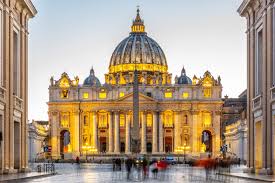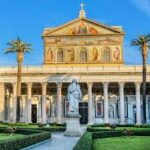Have you ever wondered why the Church celebrates St. Peter and St. Paul on the same day, 29 June? The tradition can be traced back to at least the third century. It is commonly believed that the two apostles were martyred on the same day, albeit three years apart, in circa 64 AD and 67 AD, respectively, under the infamous Emperor Nero. Another theory is that the day marks the anniversary of the translation of their relics. These are two of the most important explanations for the joint celebration, possibly instituted in the year 258.
Before the Christian era, 29 June marked the pagan festival of Romulus and Remus, legendary twins who founded Rome. Romulus was the city’s first king, but its founding date was not 29 June, but 21 April 753 BC. And, whereas the blood brothers founded the City of Seven Hills, brothers-in-the-faith St. Peter and St. Paul founded Christian Rome and are the patron saints of the Eternal City. So, regardless of the backstory, it can well be said that the Church Christianised the date in question.

Origins
St Peter is the founder of the See of Rome, and like him, St Paul too preached the Christian faith in the city. It is there that both were executed and buried. Peter was crucified, upside-down at his request, because he claimed to be unworthy to die on the Cross like his Lord. He was buried on Vatican Hill, and centuries later, St. Peter’s Basilica rose over his tomb.
Paul, on the other hand, was prescribed death by decapitation, given that he was a Roman citizen; crucifixion was a punishment reserved for non-citizens and slaves. His remains are housed in the Basilica of St. Paul Outside the Walls.
However, the two apostles are not linked in death alone. There are several other similarities and dissimilarities in the lives of these two seminal figures of the early Church.
Peter, originally Simon, was a fisherman of Galilee. He was the first of the apostles to recognise that Jesus was ‘the Messiah, the Son of the living God’ (Mt 16: 16). Jesus named him Cephas (Petrus in Latin), which means ‘Rock’ in Aramaic, for he was to become the rock upon which Christ would build His Church. Although he had pledged his fidelity until death, he had a momentary loss of faith – for example, when walking on water with Christ – and on the night of Christ’s Passion, he thrice denied Him.
Paul, originally known as Saul, was born in Tarsus, a city in south-central Turkey, near the Mediterranean coast. He was a well-educated Jew and Pharisee. Whereas Peter had a personal relationship with Jesus, Paul never met Christ face to face, but scorned His teachings and persecuted Christians. When on a hounding mission to Damascus, his dramatic encounter with Christ changed it all for him.

Turnaround
‘Every way of a man is right in his own eyes, but the Lord weighs the heart’ (Prov. 21:2).
Despite Peter’s many shortcomings, God chose him to shepherd His flock. The Acts of the Apostles notes that, in his capacity as the first bishop of Rome, he endured persecution and ensured that Christians kept the faith. St Peter is credited with writing two epistles: 1 Peter and 2 Peter. However, some scholars suggest that they may have been written by proxy.
Saul’s turnaround was even more spectacular. He continued on the road to Damascus with a contrite heart, received baptism, and got back his sight. Saul then became Paul. Breaking thus with his Hebrew identity, he exclusively used his Roman name, more familiar to Gentiles of the Mediterranean world, to reach a wider audience with the Christian message.[1]
St Paul spent the rest of his life in apostolic labours unequalled in Church history. While 13 letters included in the New Testament are traditionally attributed to him, many scholars believe that only seven are authentically Pauline: Romans, 1 and 2 Corinthians, Galatians, Philippians, 1 and 2 Thessalonians, and Philemon. The authorship of other letters, such as Ephesians, Colossians, 1 and 2 Timothy, and Titus, is debated.

In our times
Peter and Paul are twin pillars of the Church. Their activity as the first Pope and as the Apostle to the Gentiles throughout the Roman Empire, respectively, quickly established Rome as the headquarters of the Church. The later recognition of papal primacy and the eventual establishment of the Vatican City within the city solidified its position as the Church’s central location.
The close association of Peter and Paul is clear. It is seen in theology and in art. There are also many churches dedicated to the pair. That is because, although distinct in origin and temperament, their ministries and teachings are complementary. This is all the more reason to celebrate them together. A partial indulgence is granted to the faithful who fervently recite the prayer in honour of the apostles on the Solemnity,[2] and a plenary indulgence to those who devoutly use a sacramental blessed by a bishop, provided they make a valid profession of faith during its use.[3]
Way back in the year 395, St Augustine of Hippo said of St Peter and St Paul: ‘Both apostles share the same feast day, for these two were one; and even though they suffered on different days, they were as one. Peter went first, and Paul followed. And so, we celebrate this day made holy for us by the apostles’ blood. Let us embrace what they believed, their life, their labours, their sufferings, their preaching, and their confession of faith.’
Notes
[1] In the first century, it was common for individuals to have dual names, one Hebrew and the other Roman, which they used interchangeably.
[2] “Partialis indulgentia conceditur christifideli qui orationem Sancti Apostoli Petre et Paule devote recitaverit. ‘Sancti Apostoli Petre et Paule, intercedite pro nobis. Protege, Domine, populum tuum; et Apostolorum tuorum Petri et Pauli patrocinio confidentem, perpetua defensione conserva. Per Christum Dominum nostrum. Amen.” (in Enchiridion Indulgentarium, Concessiones, n°. 20, Libreria Editrice Vaticana, 4th edition, 2004, p. 67).
[3] “Christifidelis qui pietatis obiecto (crucifixo, cruce, corona, scapulari, numismate), a quovis sacerdote rite benedicto, pia utitur mente, consequitur indulgentiam partialem. Si autem pietatis obiectum a Summo Pontifice aut a quolibet Episcopo fuerit benedictum, christifidelis, eodem obiecto pia utens mente, assequi potest etiam indulgentiam plenariam die festo SS. Apostolorum Petri et Pauli, addita tamen, qualibet legitima formula, fidei professione.” (in Enchiridion Indulgentarium, Normae, n°. 17, Libreria Editrice Vaticana, 4th edition, 1999).
References
https://www.catholicnewsagency.com/saint/sts-peter-and-paul-501
Catechism of the Catholic Church
Encyclopaedia Britannica
Freemantle, Anne (Ed.). The Papal Encyclicals in their Historical Context. New York: New American Library, 1956.
Most interesting biographical notes of St. Peter and St. Paul. It always intrigued me that Peter, a fisherman, could write those Epistles I have now learned from you that they were written by proxy. It makes sense; I was particularly taken by the soaring eloquence of 1 Peter 2: 9-10. Thank you very much, Óscar, for this enlightening and inspiring homily.
Thank you, Antonio. 1 Peter 2: 9-10 is not only poetic, it’s a spiritual delight and provides a great psychological boost. Always loved those lines.